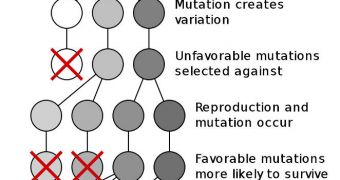Scientists say that mutations which aid evolution tend to interfere with each other's actions, when the effects they are causing are beneficial to the host organism. This might help explain why the rate of improvement in organisms is usually high early on, only to decrease after some time
In past studies, experts grew bacteria in isolated cultures in the lab, and then subjected them to new environmental factors, to which the microorganisms had to adapt, or face destruction. Naturally, the simple organisms had no problem tailoring their behavior to meet the new demands.
While this was happening, beneficial mutations appeared in the cell cultures at a very high rate. After the initial risk of destruction was eliminated, the mutation rate mysteriously decreased, scientists say.
Ever since these studies were carried out, researchers were curious to learn whether the slow-down was caused by the interactions between the mutations, or by the fact that later mutations could only have smaller effects.
A new investigation demonstrates that the first explanation is the correct one. Beneficial mutations literally hold each other back, which implies that successful organisms tend to become less capable of improvements once they already reach a high degree of adaptation.
Details of the new research appear in the June 3 issue of the top journal Science. The work, which involved creating 32 new strands of the Escherichia coli (E. coli) bacteria, was carried out by an international collaboration of experts, Science News reports.
The team surveyed 5 mutations that had developed in the cultures. Scientists with the group were raising these microorganisms for thousands of generations. For this research, they paired beneficial changes that appeared separately, and in different genes, in single organisms.
“My naive hope was that we’d see really dramatic, idiosyncratic interactions. I really wasn’t expecting to see this gentle, but consistent pattern,” University of Houston evolutionary biologist and study coauthor Tim Cooper explains.
When the two mutations were combined, the overall positive effect on the bacterial cultures were less pronounced than what the team expected. The rate at which the bacteria multiplied was not as high as it should have been, had both mutations taken hold completely.
The only logical conclusion to draw from this is that the two mutations interfered, hampering each other's beneficial actions. This is “the kind of experiment Darwin would have loved to be able to do,” says University of Pennsylvania molecular evolutionary biologist Joshua Plotkin.

 14 DAY TRIAL //
14 DAY TRIAL //